The expectation to run teams and organizations in a more agile, fluid manner is continuing to grow and become the norm, not the rule. The best part of the growing popularity of OKRs (Objectives & Key Results) is how this practice creates agility because it’s based on managing and planning in quarterly increments.
As we’ve noted in other guides, OKRs are all the rage, made popular by Google, as a methodology for goal setting and driving accountability throughout high-growth organizations. While you may not be using OKRs specifically, you can adopt the agile process of establishing a quarterly rhythm.
Driving agility comes from the management cycle of revising results and refreshing goals quarterly, with annual company-wide priorities backed by monthly progress reporting.
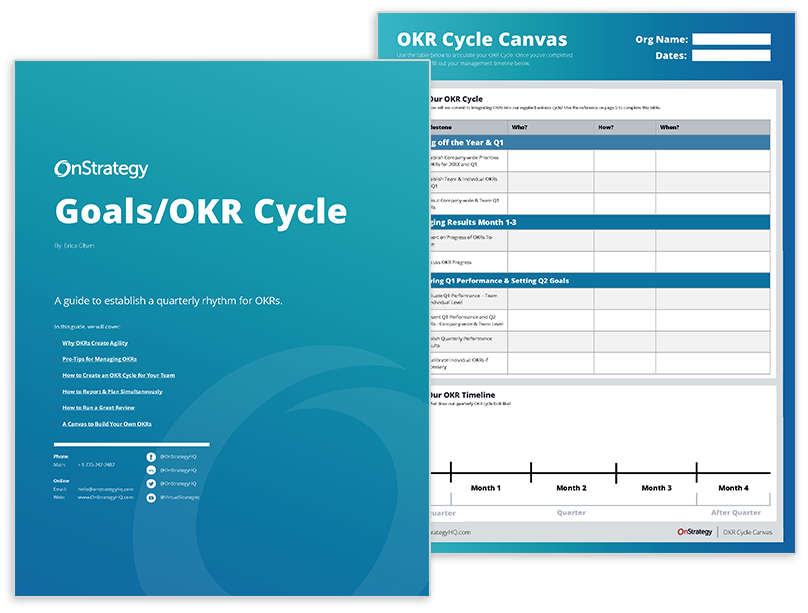
Standard Rhythm
Our best practice is to fit the management rhythm with organizational pace and market demands. Here are the most common increments:
- Weekly Update: Starting with the shortest time period, weekly reviews shouldn’t just be focused on OKRs. Instead, we recommend integrating a component of the OKR review process into your regularly scheduled weekly tactical meetings. These weekly tactical meetings cover the operational elements and weekly priorities of your team, their activities, and what needs to be accomplished during the next 5-7 days.
- Monthly Check-In: Monthly reviews are purpose-built sessions to review the performance of your OKRs and decide what are the critical actions you need to address in the next 30 days.
- Quarterly OKR Review & Refresh: Quarterly reviews are sessions designed to review your performance and articulate focus for the next 90 days. We consider quarterly OKR strategy reviews table stakes when it comes to the OKR planning process. The absence of quarterly strategy reviews is a surefire way to lose focus on how your organization is trending towards its goals, quarterly, annually, and long term.
- Annual Review & Planning: Annual planning is designed to look back on performance of your team during the past 12 months and articulate the bigger focus for the coming 12 months. This is the most traditional planning sequence. We still recommend leveraging this cycle, but it should be accompanied by another review sequence.
Don’t Over-Plan
Once you’ve determined the increment for which you want to manage against your OKRs, you’ll need to work with your Executive Team to set annual company-wide Goals/Objectives. Then, work with their teams to set quarterly Key Results/Deliverables. You can read about how to create OKRs here!
Measuring the performance of Key Results is [traditionally] assessed quarterly. The next quarter’s Key Results should be set based on your previous performance and emerging themes.
The purpose behind this is to create agility and not “over-plan” work. Instead, you’re planning and managing OKR results quarterly, which helps create a more exciting and dynamic goal setting practice than setting annual goals you forget about.
Keeping the Rhythm
We know the “pro” of this approach is building agility into your organization. The “con” is the process can buckle under its own weight if not managed simply and seamlessly. Here are a few tips:
- Rigorous Consistency: Establish the cycle and dates for the year. Publish them and commit. Do not cancel meetings.
- Company-wide Visibility: Not only do you want to discuss results at a team or company-wide meeting, you also want to publish results physically via dashboards or other reporting mechanisms.
- “Aspirational” Commitments: As a team, you win and lose together. The act of making quarterly commitments (via setting individual OKRs) and reporting on them can feel punitive. Remember that achieving around 70% of key results is the idea. In other words, some “reds” and “yellows” are Okay.
How to Create an OKR Cycle for Your Team
Below is an illustration of a standard quarterly OKR cycle. To make this work for you, here are a few questions to answer. Use your answers and the worksheet in the free guide to build a quarterly process that will fit your team.
- What system or tool will you use to capture and manage OKRs?
- Will monthly check-ins be conducted as part of 1:1s or included in your monthly staff meeting?
- Will your Quarterly Business Review be part of an existing meeting or a new meeting?
- Do you want to include dedicated time for strategic topics at your Monthly/Quarterly Business Review or will those be handled at different meetings?
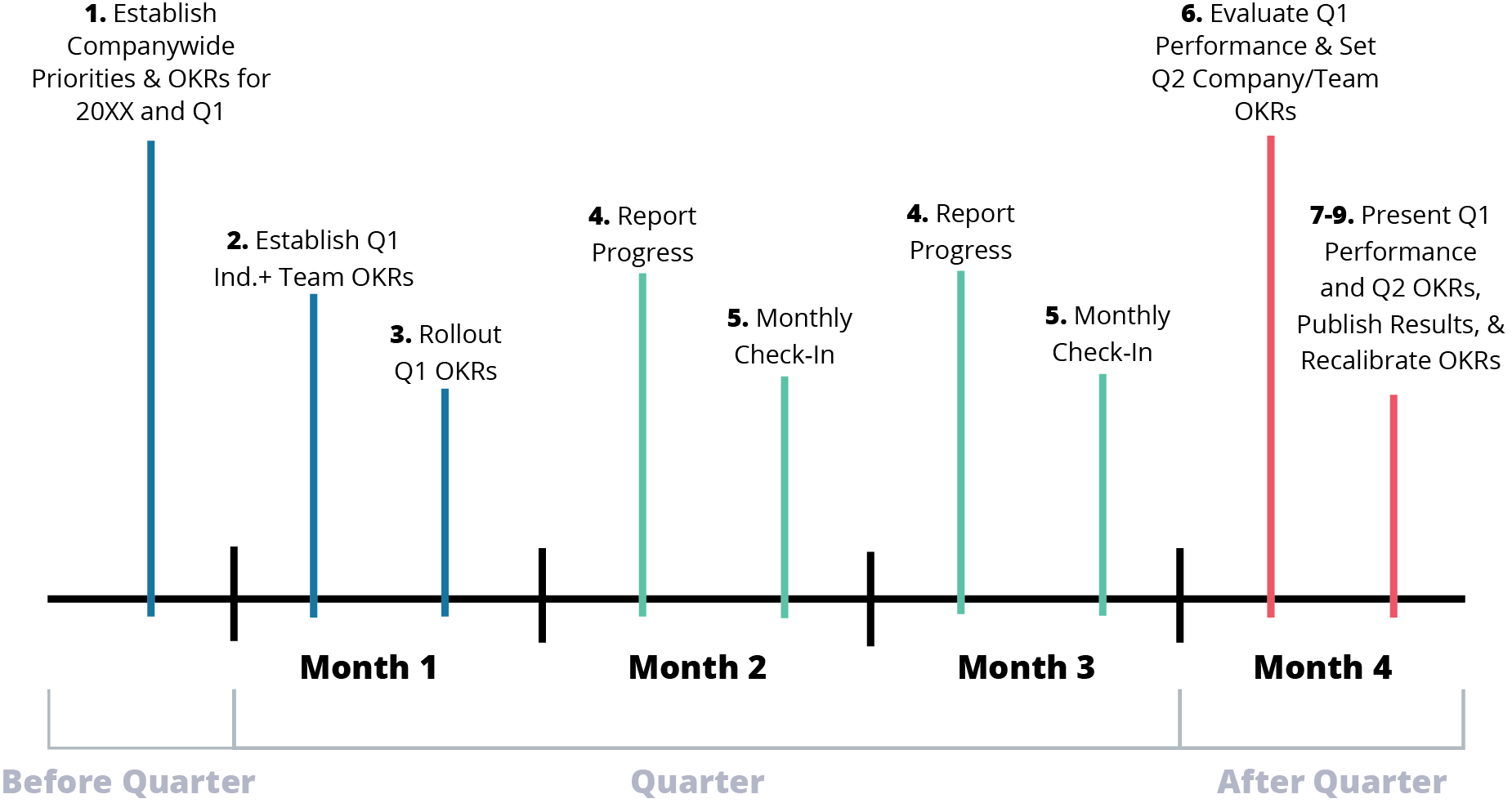
How to Develop Your OKR Cycle Step-by-Step
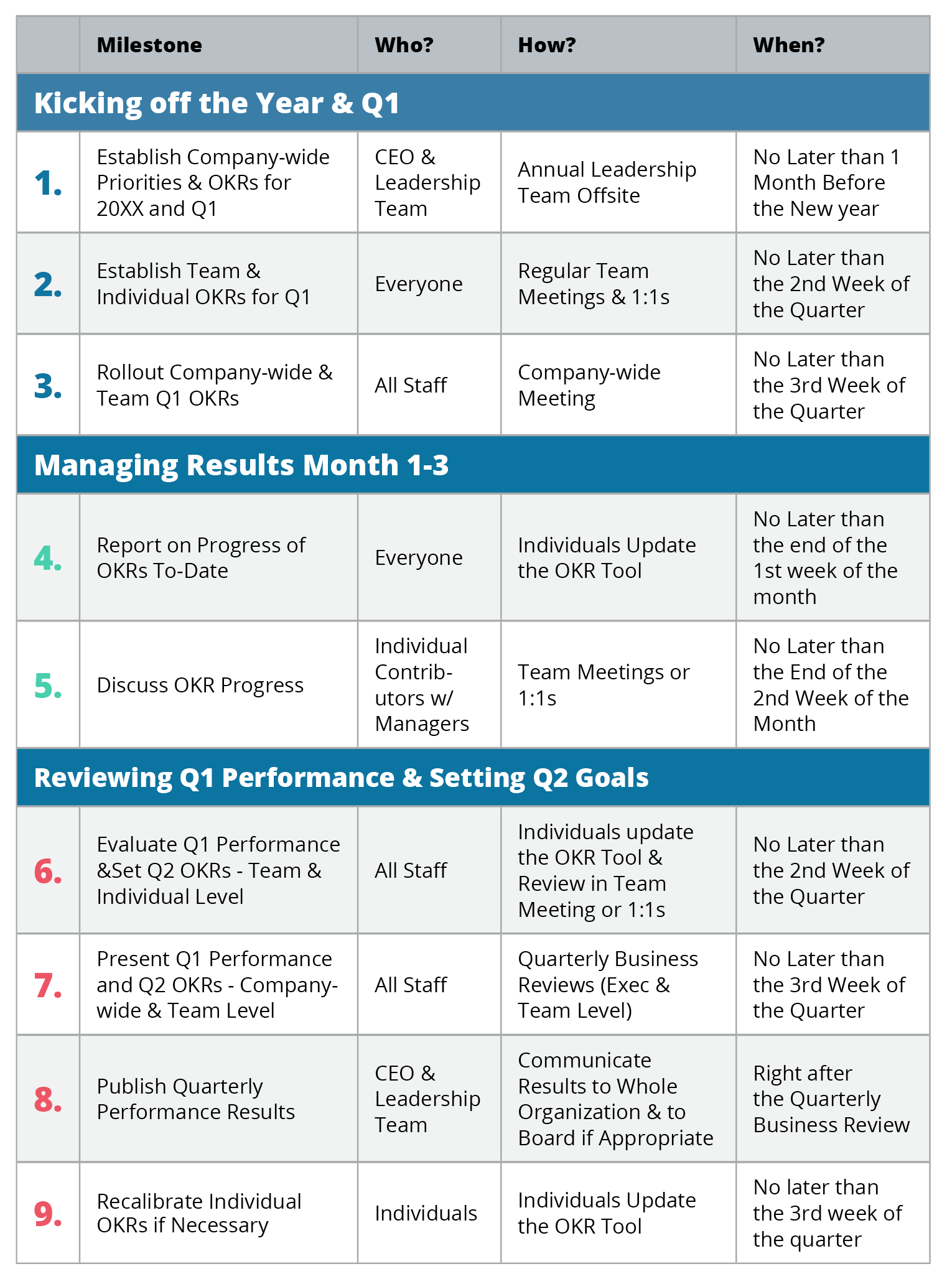
How to Report on Performance & Plan Simultaneously
The trickiest part of streamlining an OKR cycle is reporting on performance and establishing the next quarter’s goals at one time. Here is how we think about this process to make this easy. For every key result, goal or initiative, think about the three “C’s”:
- Close Out: Close out the key result by reporting on the actual progress or metric achieved at the end of the third month.
- Carry Forward: Determine if this key result will continue into the next quarter. If so, extend the end date to the end of the third month and establish the desired target.
- Create New: Determine if any new key results need to be established to achieve the objective. If so, write new key results; establish the target and set the end date for the end of the third month.
For whatever OKR software tool you are using, you need to output the Performance Report for the previous quarter and the Action Plan for the upcoming quarter.
Refreshing OKRs Pro-Tip
While you are “refreshing” your OKRs every quarter, most often you will carry forward the objective and most of the key results (specifically quantifiable outcomes). What you will “refresh” is establishing the target for the next quarter and likely new key results that are efforts or initiatives.
Running a Great Monthly/Quarterly Business Review
The heartbeat of a productive Goal/OKR Cycle is a Monthly or Quarterly Business or Strategy Review. There are many different ways to run this meeting, however here is a tried and true agenda to start with and evolve to your culture.
- Time Allocation: Monthly for 60 mins or quarterly for 2 hours.
- Attendees: Executive Team or Directs if running a team review.
- Preparation: All Goals/OKRs have current performance data through the end of the quarter.
- Purpose: To review company-wide performance goals/OKRs driving Strategic Priorities and calibrate focus for upcoming quarter. (NOTE: This meeting is NOT public shaming for non-performance. That is handled in 1:1s, of course.)
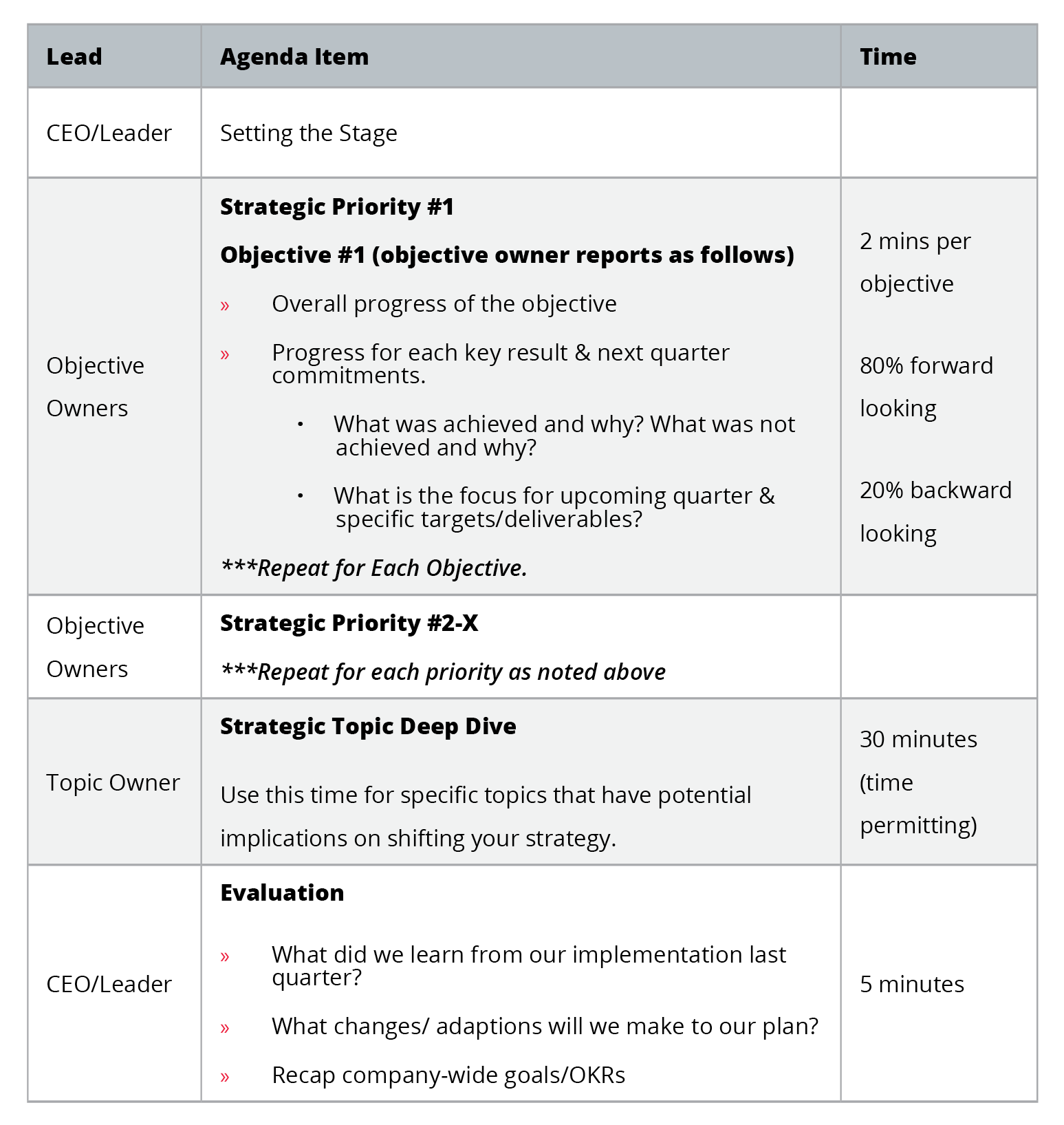
Using the OS App to Manage your OKRs
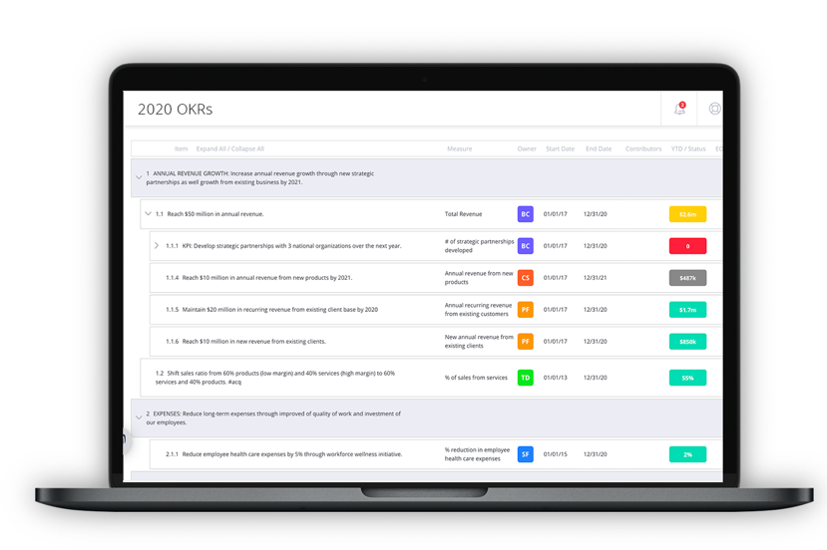
The OnStrategy Team built our application to holistically and easily manage organizational, team and individual performance. Built into our code is the philosophical approach noted above. You can easily:
- See a quick view of your team’s performance.
- Collect performance updates in 15 minutes or less.
- Automatically see company-wide performance and pre-built dashboard to run quarterly reviews.
- Everyone on the team can see how they contribute to the bigger picture.
- Quickly refresh and reset OKRs quarterly.
Click here to talk to a Senior Strategist to look under the hood!
A Canvas to Create Your OKR Cycle












